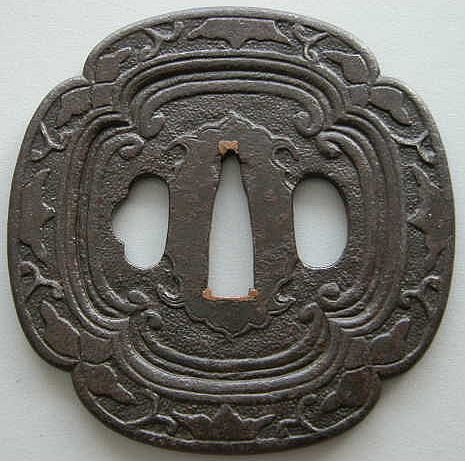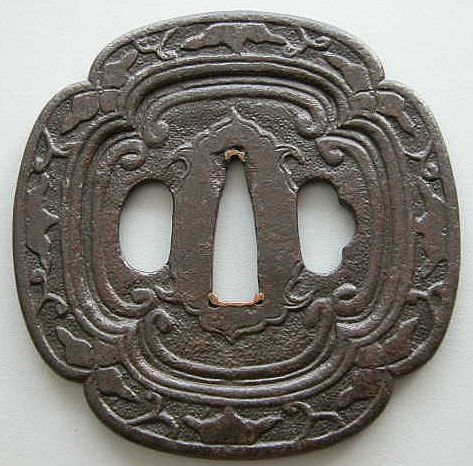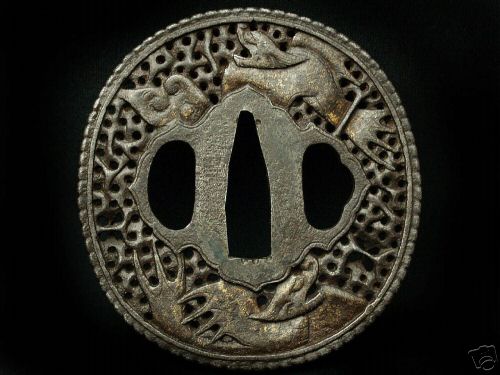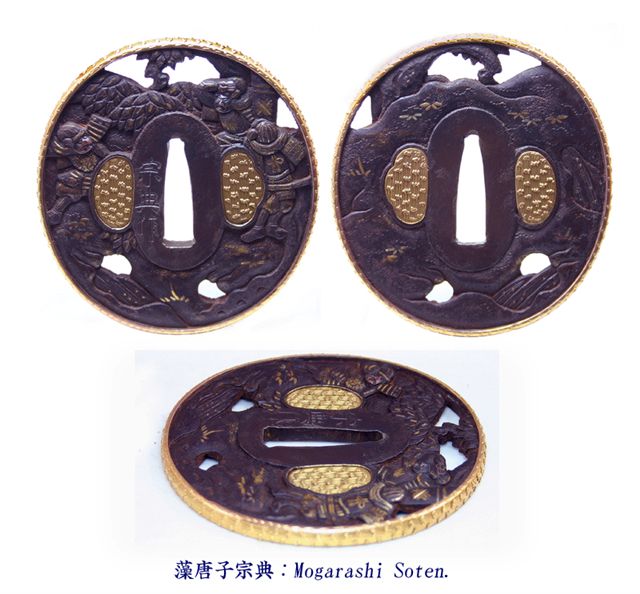IN HIRADO, NAMBAN, AND HIZEN TSUBA JAKUSHI AND SOTEN OF HIKONE | |
|
In the late sixteenth and early seventeenth century certain swordfittings began to appear which registered strong traces of foreign influence, both Chinese and European. Two great events in that period, the arrival of the Portuguese in 1542 and the conquest of Korea by Hideyoshi in 1592, brought with them into Japan innovations which rapidly had strong effects on many of the arts and crafts. European characters, in monograms or inscriptions, figures of foreigners, and coats of arms were soon woven into purely Japanese designs in the most itigenious manner ; even the Umetada artists combined European letters in some of the decorations on their sword-guards. Grounds simulating leather became very popular both in metal work and lacquer, presumably under Portuguese influence; and, as has already been remarked, inlay in iron noticeably increased with the introduction of European fire-arms. Two types of sword-fittings grouped under the names Hirado and Namban reflect to a marked degree these foreign currents. In the town of Hirado in Hizen worked a coterie of craftsmen who specialized in brass and iron sword-fittings chased with designs of dragons, waves, and flowers almost always combined with European letters. Those which are signed usually have upon them the names of Kunishige, an artist, who must have been the leading spirit of the group. In the seventeenth and eighteenth centuries, Hirado like Nagasaki, became the market-place for many "ready made articles" (shiiremono) , intended for the swords of the merchants and lower samurai, and also to satisfy the demands of the foreigners who might carry them home. The type of tsuba known as Namban was likewise made by the hundreds and imported to some extent. The word Namban meaning "southern barbarians" was first used by the Chinese to describe all aboriginal tribes inhabiting the southern part of their country. 1 In Japan from the sixteenth century on it designated all foreigners, Portuguese, Hollanders, as well as other Europeans. The word has also been applied to a peculiar kind of hard iron, harder than ordinary iron, but not as brittle as steel. It may have been imported from the Malay Islands, Java, or India. At any rate, it was utilized effectively for the production of the early so-called Namban tsuba, the date of which has been fixed by most writers as late sixteenth century. While some of the designs on these guards plainly show European influence, such as figures, Dutch boats, and birds, for the most part Namban tsuba are thoroughly Chinese in impression, and are combinations of intricately chiselled designs of dragons and tendrils with the jewel appearing somewhere in the scheme. Guards of this type, on account of their Chinese character, are quite often called Kannon or Kanton tsuba. In some cases the design itself is beautifully proportioned and therefore appealing; for the most part, however, the admiration aroused for these tsuba is due to the technique displayed in the skillful undercutting of the tendrils and dragons which are intricately interlaced. The two Namban tsuba on Plate XVIII, while similar in their general effect, have distinguishing characteristics that are of interest. Fig. 2 is round, of iron, with touches of gold nunome and bounded by a plain rim. The chiselled design is that of two dragons affronte with a round jewel-like object between them at the top of the tsuba. At the base is a formalized presentation of the Chinese character shou ("long life"). The dragons are of the five-clawed imperial type, scaled beings with flaming appendages, and they are writhing through a network of scrolls, which possibly represent clouds ; the whole design is carved in the round. Of quite a different form is a tsuba more oval than the round and decorated on the chiselled edge with a pearling which represents the petals of the chrysanthemum. As is often the case with certain Namban tsuba, the seppa dai is of an ornamental form pointed at the top and base. On other tsuba it is squared and covered with a wave design. The dragons in this case are more crudely drawn than those on the circular guard, and have tails of fan shape. They are likewise intertwined with a complicated scroll motive, and are facing a jewel.
This ornamentation of two dragons flying toward a ball or flaming spiral is an ancient and frequent motive in both Chinese and Japanese art. A common explanation in China is the Buddhistic idea of the eager striving of the dragons for the "pearl of perfection," thus identifying the dragon with the Indian Naga and the ball with the precious pearl (cintamani) which grants all desires. In Japan the dragon generally represents the genius of rainfall, as may be seen in the dragon festival on the fifteenth day of the first month, wherein the huge dragon is carried through the streets pursuing a ball which is borne at the head of the procession, and which is the symbol of the thunder that has been belched forth by the creature who apparently seeks to repossess it. M. De Visser1 discusses at length the meaning of the two dragons with open mouths flying toward the jewel, quoting several opinions and citing a certain Chinese picture wherein two dragons face a fiery spiral-shaped ball. Beneath is the title, "A couple of dragons facing the moon." This interpretation he is inclined to favor, since he thinks it reasonable that the dragons, which are the clouds, would wish to swallow the moon, the symbol of fertilizing rain thereby storing up the water with which they later would bless the earth. He adds, "We know the close connection of dragons and pearls in both religions (Buddhism and Taoism). This connection is quite logical; for the masters of the sea are, of course, the possessors and guardians of its treasures. When the clouds approached and covered the moon, the ancient Chinese may have thought that the dragons had seized and swallowed this pearl, more brilliant than all their pearls of the sea." As to the true meaning of the design, whether the "jewel" represents the thunder, the moon, or the pearl, writers are still at variance ; the primary interest in this study centers on the fact that this Chinese idea influenced the Namban group of artists for three centuries. The early Namban tsuba are rarely signed, but after the style became popular, scores were made at Kyoto and Nagasaki which have the signatures of mediocre artists. On account of a certain similarity of technique and quality of iron, the Hizen tsuba are often classed along with the Namban guards, though their predominant decoration is of such individuality as to warrant a distinct grouping. It was in the late eighteenth century that Mitsuhiro of Yagami in Hizen began making sword-fittings of iron chiselled in openwork with a design of a hundred monkeys. He was followed by a son of the same name and by Yoshitsugu, a Nagasaki artist, both of whom improved upon the technique of the founder and added to the family repertoire designs of a hundred horses, a hundred rabbits, and other "hundreds." The tsuba is unsigned, moko-gata, and filled within the slender rim with figures of monkeys carved in all attitudes distinctly different on the two sides of the tsuba. The seppa dai is chased with the formal wave design common to these pieces. A small fuchi in this collection is covered entirely with monkeys whose eyes are inlaid in gold. Certain Hizen tsuba are solid placques inlaid in silver nunome with a design of dragons or birds strongly reflective of Chinese influence.   The only port open to foreigners, during the time of the exclusive policy of the Tokugawa shoguns, was that of Nagasaki in Hizen, where the Dutch were allowed to land a limited number of boats, and where imports from China were pouring in, constantly refreshening the stream of inspiration from which the Japanese had so freely partaken. In the late seventeenth or early eighteenth century, a certain custom's official of Nagasaki, named Jakushi Kizayemon, was greatly influenced by his association with the people and objects to be seen in this port. He was at first a painter, but is said to have learned from the foreigners the art of etching metals in relief by means of acids, whereupon he transferred his attention from painting to working in metal. He soon became a noted maker of tsuba and applied to the iron grounds which he always used, brilliant designs suggestive of the Chinese artists who had been the source of his inspiration as a painter. These decorations are combinations of relief in iron covered over with very fine nunome-zogan in varying shades of gold and silver. Dragons in the waves, birds flying through clouds, and occasionally figures were depicted by this artist, but it was in the pure landscape that he excelled primarily, introducing, as he did through his tsuba, the detailed stretches of mountain scenery suggested by contemporary paintings from the continent. The unsigned tsuba is thoroughly characteristic of the work of this artist and his followers, and from the excellence of technique is judged to be an authentic product of Jakushi II, who was a son of Jakushi I, and whose work resembles closely that of his father. It is of mokko form, of brown iron, and covered on both sides with a charming landscape in pure Chinese style. On the obverse in relief covered over with delicate nunome-zogan of three shades of gold, rocky promontories tower up into a sky flecked with golden clouds beyond which a full silvery moon emerges. Below, rocks of lesser height and pine-clad, overhang a lake whereon five small sailboats and a larger junk are inlaid in relief of silver and gold. Two tiny figures, in relief of shakudo, are walking out on a bank beneath pavilions nestled in the rocks. The scene continues on the reverse side, where another small figure is seen crossing a bridge over the shining waves, and about to enter another rocky retreat. Jakushi II, also known as Kizayemon, was even more expert than his father in this work of delicate inlay. He was followed by Yeirakudo of Nagasaki and a host of copyists who imitated with more or less success the style of the two masters. Another artist, who at first chose Chinese subjects as motives for the decoration of his sword-fittings, was Kitagawa Soten who lived in Hikone in the province of Goshu, which is the Sino-Japanese name for Omi. He not only produced solid tsuba, but also worked in marubori zogan, carving in the round decorated with colored inlay, a combination which became extremely popular, and which is sometimes termed hikone bori from the name of the town Hikone. Unfortunately, there was such a demand for this type of tsuba that a wholesale production of signed and unsigned copies of tawdry appearance took place at Aizu in the nineteenth century; and many of these examples have crossed the waters and become the representatives of this school in several collections, thereby falsely prejudicing a number of people against all work of this name. The genuine products of Soten I and his son Soten II, when carefully studied, evoke admiration and interest both on account of their technique and the subjects illustrated. The foundation metal is usually iron, though there is an excellent shakudo tsuba in this collection. At first Chinese subjects seem to have engrossed Soten I, but later incidents from Japanese history and folk-lore were realistically portrayed bringing out episodes of intense interest. The costumes and armor on the figures are often inlaid with great care and effectiveness, the faces are generally in relief of copper or silver, while the landscape is encrusted with gold nunome-zogan. Soten I, also known as Shuten, lived in the early part of the seventeenth century. He probably used the name Soheishi and the title Niudo, which originally indicated retirement from worldly affairs to the calm of Buddhistic contemplation. 1 Both of these names were adopted by Soten II, who is said to have inscribed his name in a larger and bolder manner than his father. The school of Hikone was carried on by certain members of the Nomura family, chief among whom was Kanenori (early eighteenth century), a pupil of Soten II, who closely followed his master's style. Two incidents in Japanese history are vividly portrayed on different tsuba, both of which are of iron. The first is signed: "Soten who lived in Hikone in Goshu." The scene depicted is that known as Fuji no-makigari ("Hunting at the base of Fuji"), a pastime of great popularity under the Kamakura shoguns. The second tsuba (pictured below) is of another dramatic incident which occurred at the important battle of Danno- Ura (a.d. 1185), the decisive victory of the Minamoto over the Taira, which is mumei (attributed to Niudo Soten Sei Soheishi Hikone jiu Goshu).  One is impressed by the fact that these artists undoubtedly deserve a place among the skilled workers in metal, and that they have also left some important historical documents in their carefully conceived designs. |


